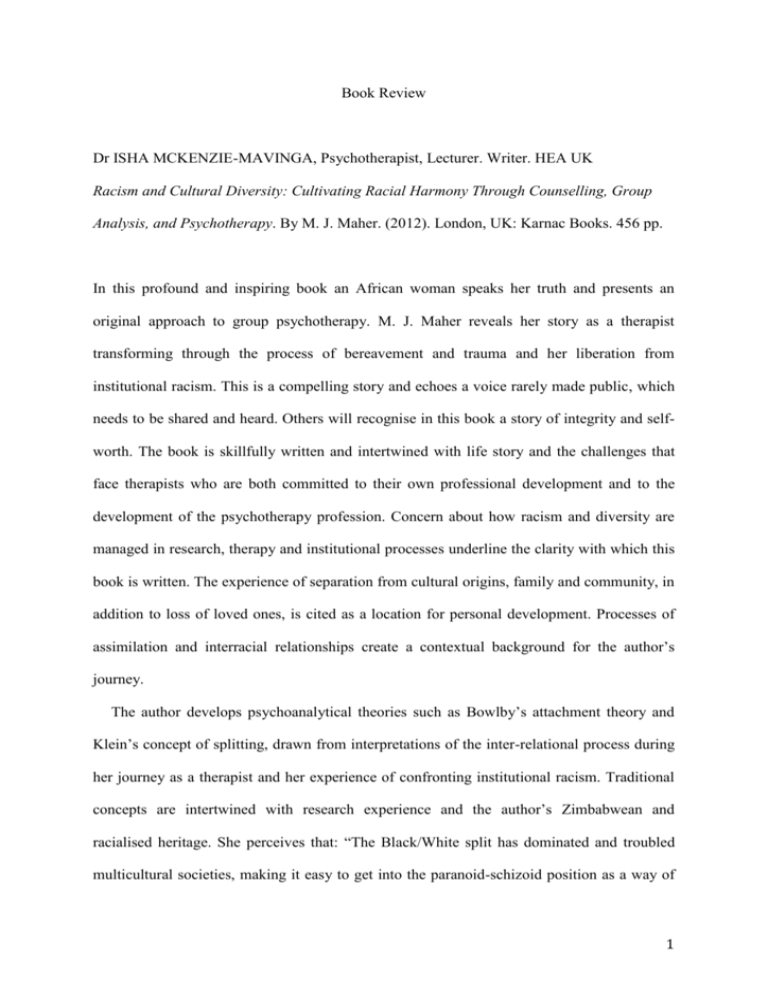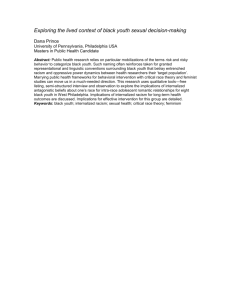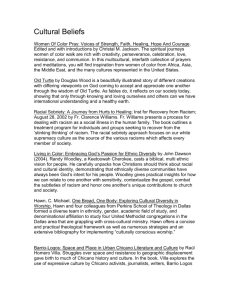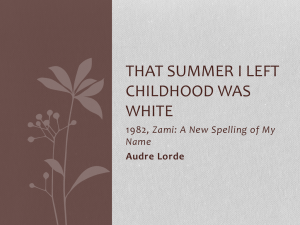Review - WPF Therapy
advertisement

Book Review Dr ISHA MCKENZIE-MAVINGA, Psychotherapist, Lecturer. Writer. HEA UK Racism and Cultural Diversity: Cultivating Racial Harmony Through Counselling, Group Analysis, and Psychotherapy. By M. J. Maher. (2012). London, UK: Karnac Books. 456 pp. In this profound and inspiring book an African woman speaks her truth and presents an original approach to group psychotherapy. M. J. Maher reveals her story as a therapist transforming through the process of bereavement and trauma and her liberation from institutional racism. This is a compelling story and echoes a voice rarely made public, which needs to be shared and heard. Others will recognise in this book a story of integrity and selfworth. The book is skillfully written and intertwined with life story and the challenges that face therapists who are both committed to their own professional development and to the development of the psychotherapy profession. Concern about how racism and diversity are managed in research, therapy and institutional processes underline the clarity with which this book is written. The experience of separation from cultural origins, family and community, in addition to loss of loved ones, is cited as a location for personal development. Processes of assimilation and interracial relationships create a contextual background for the author’s journey. The author develops psychoanalytical theories such as Bowlby’s attachment theory and Klein’s concept of splitting, drawn from interpretations of the inter-relational process during her journey as a therapist and her experience of confronting institutional racism. Traditional concepts are intertwined with research experience and the author’s Zimbabwean and racialised heritage. She perceives that: “The Black/White split has dominated and troubled multicultural societies, making it easy to get into the paranoid-schizoid position as a way of 1 coping with anxieties evoked by the split.” (p.210) Attention to attachment theory and the affect of a secure base as a child and in the therapeutic relationship is given, supporting a proposal that the internalisation process influenced by early caregivers can include messages of a racial and cultural context and remain with an individual into adult relationships. The description of inter-cultural relationships and intra- and inter-racial processes resonate in many ways with the pain that Black individuals and some Black therapists endure. These areas of inter-relationship are key to creating an understanding of racism and cultural diversity across the racial divide and within Black and White communities. The reader is engaged in a rare peek at these processes in the context of individual experience. There is no sense of washing dirty linen in public, just a holistic picture that gives a sense of the unseen and often unheard Black African voice. The book reads as an uncensored account of this individual’s first generation African female psychotherapist’s reality. It is easy to appreciate the achievements and challenges of the author’s story and travel along with her as she describes her truth. The book is complemented by descriptions of the author’s research, as she owns that being a Black African woman, raised in a Black community in then Rhodesia influenced the way she conducted the research. She uses Shona language and sayings and words such as the term “babamukuru” which refers to the passing of a child, in the event of their father’s death into the care of their father’s eldest brother. Impressive illustrations also create symbolic representation of psychodynamic insights, for example, the choice of the bamboo (Phylostachys nigra), the Black hardy bamboo that can survive bitter winters, to symbolise the author’s determination and survival of various life struggles. Her approach reflects the endurance of both the psychotherapist and the client. Insights about racism, association with racism, and ways of rising above institutional, internal, personal racism and racism in the clinical setting are all considered. The author reflects on the issue of her internalised racism in supervision: 2 When this was explored in supervision, I realized that with the Black patients I acted out my internalized racial stereotypic belief that Backs are poorer than Whites. By agreeing to the fee reduction I was confirming the belief that I was not good enough and did not deserve to be paid as much as White therapists and that Black therapists are not worth much, are not as good as White therapists, thus devaluing their therapy and myself. (p16) In addition to her own experience of supervision, in response to some research she conducted she observed a certain silence about supervision which seemed to indicate a reluctance to explore the negative transference; in her words: “The silence about supervision made me wonder whether there was a problem with it, because I noticed that when participants are not happy about something they fall silent.” (p 302). This silence has consistently been identified as a behavioral pattern in response to the challenges of discussing racism in psychotherapy training and relational process. (Tuckwell, 2002,p138. Mckenzie-Mavinga, 2009,p35) On the other hand, trainees who spoke about skin colour with various people, particularly their therapists, were confidant and containing of the “racist” client. The author’s authentic approach to group therapy using symbolic representation of animals from her cultural background and her use of imagination challenges traditional therapists to work outside the box. She presents a journey through individual and shared experiences whilst skillfully intertwining professional development and engages the reader with her own transparency. M. J.Maher describes her personal research, exploring the question: “Can psychotherapy penetrate beyond skin colour?” This is a poignant question and one that is answered by means of an in-depth critical analysis, which takes into account the intimate connection between the therapist and researcher. Maher describes a multi-method qualitative approach 3 that includes Kelly’s (1955) three-phase creative cycle (p.250), and aspects of personal reflexivity (Tindall, 1994). She gathered data using questionnaires and interviews. A detailed account of the research preparation and methodology shows the importance of attending to her question in training and supervision; of nurturing training and supervision that address the link between personal development, and diversity and racism in client material, and the experience of both Black and White therapists, supervisors and ultimately clients. The author emphasizes the importance of thinking about child developmental stages when working with racism, an area that is rarely taken into account in psychotherapy training. This approach, she postulates, establishes a common ground between therapist and individual, because feelings of being ignored can be rooted in early childhood and this is what marginalization and racism does to individuals. Suggestions about ways of containing and addressing the impact of racism are presented and the importance of recognising that race is not culture is emphasized. The author concludes that skin colour does not denote culture; therefore we must be observant of the various dimensions of culture and experiences of race as a concept linked to racism. Having a dark skin can mean that a person has African or Asian heritage, but they may have never been to Africa or Asia. Having a White skin does not necessarily mean a person is British, or European. We cannot make assumptions about a black person who has internalized a White culture or a White person who had a black nanny. The differences within Black and White cultures due to geographical origins and childhood experiences also mean that we cannot homogenize cultures. Neither can we assume that black people all have the same experience of racism. Maher places this in context using her own experience of early childhood in South Africa and adulthood in the UK. There are differences within African and European cultures, even differences within regions of the UK and other countries. Therefore she proposes that therapists consider the link between childhood experiences and racial experiences. 4 The front cover of the book presents a photograph of an African woman carrying a pumpkin on her head and a White doll wrapped closely to her body, both images which symbolise the journey and content of the book. In the author’s words: “how I carried the baby on my back”. This book clearly shows the impact of colonisation on the traditions of psychotherapy, mental health institutions and the individual. Presented in an autobiographical style that presents the author’s wisdom and experience, this book is a must for researchers, trainers, therapists and professionals in the field of helping and caring. References Kelly, G.A (1955) The Psychology of Personal Constructs, Vol 1.New York: Norton (Reprinted by Routledge 1991) Mckenzie-Mavinga (2009) Black Issues in The Therapeutic Process. Basingstoke: Palgrave Macmillan. Tindall (1994) in Bannister, P., Burman, E., Parker, I., Taylor, M. & Tindall, C. Qualitative Methods in Psychology: A Research Guide. Berkshire: Open University Press. Tuckwell G (2002) Racial identity White Counsellors & Therapists Open University Press Dr Isha Mckenzie-Mavinga is a Published Writer/Poet and Integrative Transcultural Psychotherapist, Lecturer, trainer and supervisor. She taught for twenty-six years and is a fellow of the Higher Education Academy. She has published several papers from her Doctoral study on the process of understanding ‘black issues’ in counsellor training and practice. Also a chapter in Working Interculturally in Counselling Settings [Ed Dupont Joshua, A. 2002] and in The handbook of Transcultural Counselling and Psychotherapy [Ed Lago, C. 2011] Isha has worked in mental health, with women impacted by violence in relationships and as a student counsellor. Her approach facilitates dialogue and exploration of oppression, internalised oppression, and stereotyping and power relationships. She is particularly interested in the dichotomy of racism and homophobia and the use of transformation ritual in the process of healing. She facilitates transcultural supervision and has created a series of workshops supporting her book Black Issues in the Therapeutic Process. Palgrave Macmillan Publishers [2009]. www.i-mckenzie-mavinga 5







